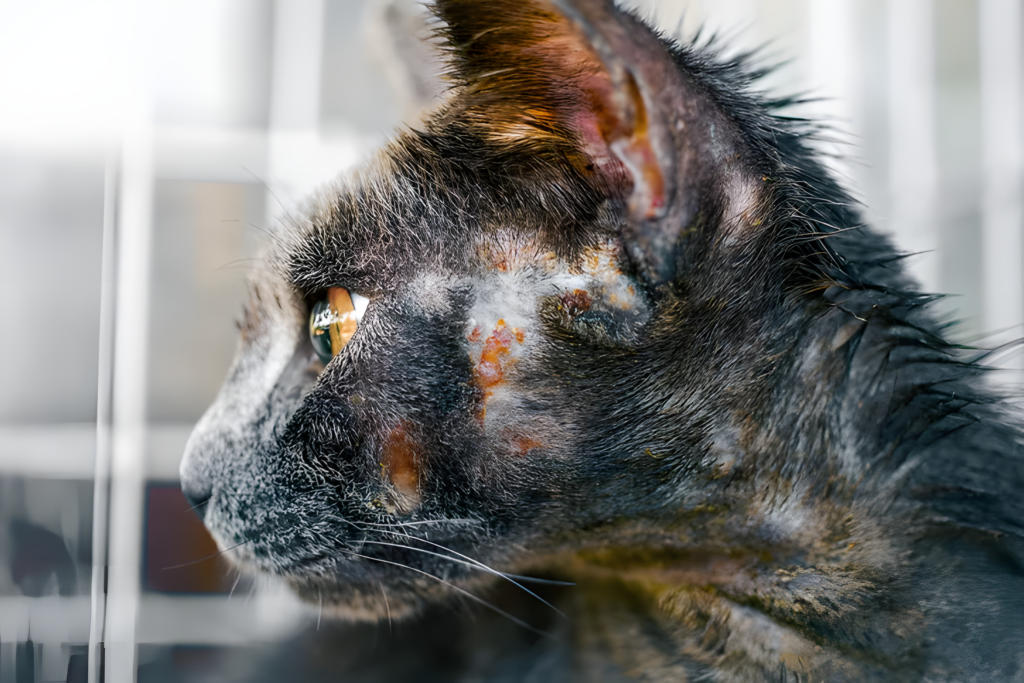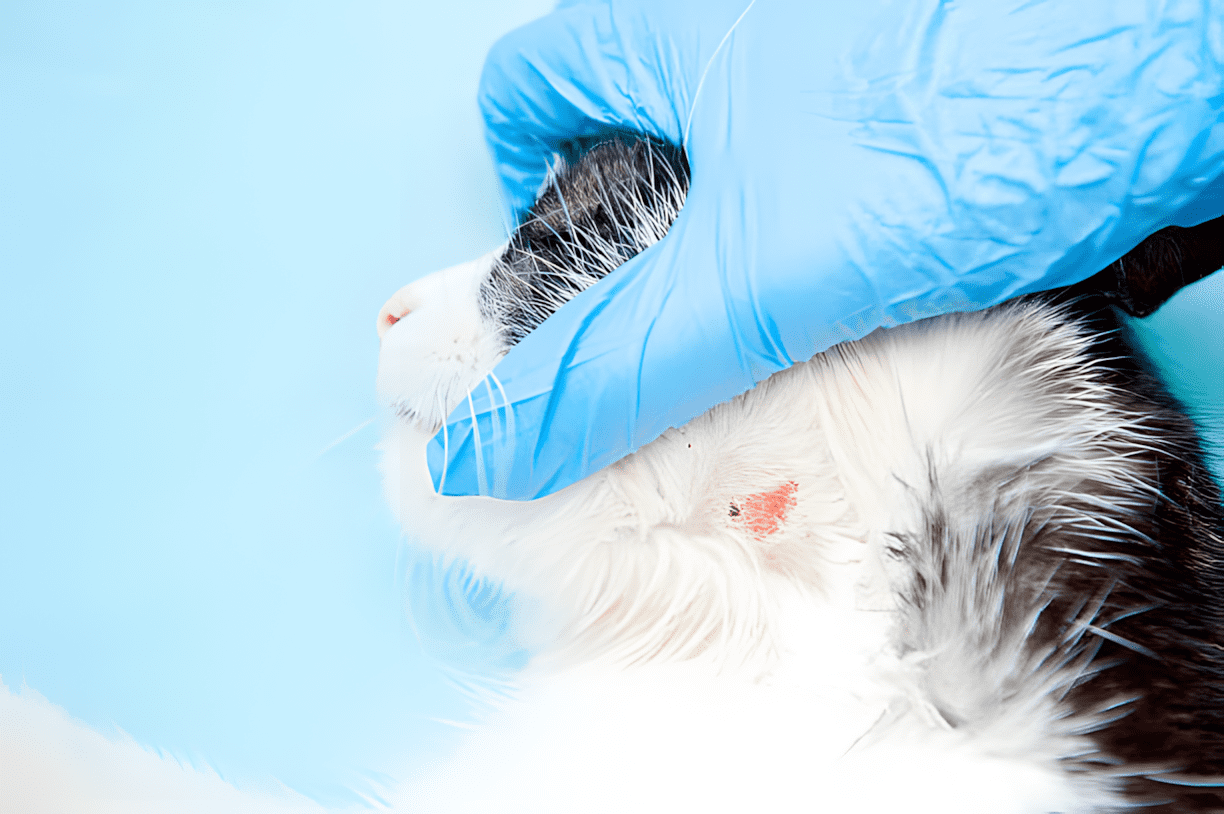Many medical terms can be confusing, but “ringworm” is one of the most misunderstood. Contrary to popular belief, ringworm in cats has nothing to do with worms. Instead, this condition, also known as dermatophytosis, is caused by a fungal infection. The primary culprit is the fungus Microsporum canis, which infects the skin, leading to a range of symptoms.

How Do Cats Contract Ringworm?
Ringworm in cats is a common fungal infection that you can’t easily avoid. The fungus thrives in warm, humid environments, making your cat susceptible. The infection isn’t limited to outdoor environments; ringworm spores can latch onto clothing, blankets, and fur, then spread indoors.
Once ringworm in cats takes hold, the fungus targets hair follicles, feeding on keratin in the skin, hair, and nails. Even though ringworm in cats is contagious, not every cat exposed will get infected. Some cats groom themselves meticulously, removing the fungus before it causes an issue.
However, it can still lead to visible infections, with symptoms like hair loss, scaly skin, and itching. Sometimes, bacteria living on your cat’s skin can outcompete the fungus, preventing infection. But for cats with weaker immune systems, ringworm in cats can persist, causing noticeable discomfort.
Ringworm requires prompt treatment to prevent it from spreading to other pets or humans. If you suspect ringworm in cats, consult your veterinarian for a proper diagnosis and treatment plan. Early intervention ensures your cat remains healthy and avoids further complications from ringworm in cats.
Symptoms of Ringworm in Cats
Ringworm often appears as a circular reddish rash, causing patchy hair loss and dull fur. Infected cats may experience itchy skin, scaling, and nail infections, leading to discomfort and noticeable symptoms. Prompt treatment helps to prevent the spread and ensures your cat’s health and well-being.
How Common is Ringworm in Cats?
Ringworm is one of the most frequently encountered infectious skin diseases in cats worldwide. Kittens, due to their developing immune systems, are particularly susceptible. Long-haired breeds and cats in high-population environments, like catteries, also face a higher risk. Cats with compromised immune systems or poor nutrition are more likely to develop an infection.
Should You Be Concerned About Ringworm in Cats?
Ringworm in cats poses health risks for both pets and humans. This fungal infection spreads through direct contact between infected and uninfected individuals. Cats can transmit ringworm to dogs, and even to people, making early detection crucial.
Though adult humans typically resist ringworm, breaks in the skin can allow infection. Children and immunocompromised individuals are especially vulnerable. If you notice suspicious skin lesions, consult your physician for advice. Prompt treatment with topical antifungal creams usually resolves the issue.
Decontaminating the environment is essential when addressing ringworm in cats. Fungal spores can survive on surfaces like bedding or carpets for up to 18 months. A bleach solution—one pint of bleach in a gallon of water—effectively disinfects hard surfaces and kills the spores. Consistent cleaning reduces the risk of reinfection and protects everyone in the household.
Ringworm in cats isn’t always severe, but it’s contagious nature demands proactive management. Regular cleaning and treatment help safeguard both your pets and family from this persistent fungal threat.
Treating Ringworm in Cats: What You Need to Know
Treating ringworm in cats doesn’t have to be a hassle. Topical antifungal medications, available as creams and sprays, effectively combat this fungal infection. Veterinarians recommend clipping fur and using medicated dips to further eliminate the infection.
For stubborn or widespread cases of ringworm in cats, veterinarians often prescribe oral antifungal medications like itraconazole. These can be flavored with tuna or other cat treats, making administration easier. Alongside medication, environmental decontamination is crucial to stop the spread of ringworm in cats and prevent reinfection.
Monitoring a cat’s progress during treatment is vital. A dermatophyte culture is the most reliable method for assessing the effectiveness of treatment against ringworm in cats. Without proper care, treatment for ringworm in cats can extend over several weeks or even months. Prompt diagnosis and treatment help minimize the discomfort caused by hair loss and skin lesions.
By addressing ringworm in cats early, you can shorten the treatment duration and ensure a quicker recovery. Remember, taking proactive measures keeps your feline friend healthy and happy, free from the irritation of ringworm.
The Importance of Early Diagnosis and Treatment
Diagnosing ringworm in cats early is vital for successful treatment. A culture for dermatophytes is the only reliable method to monitor a cat’s response to treatment. If left untreated, ringworm can persist for weeks or even months, making it essential to address any signs of hair loss or skin lesions promptly.
Preventing Ringworm in Cats: Tips and Strategies
Preventing ringworm requires diligence but is achievable. Maintaining a healthy cat with a robust coat and skin reduces the likelihood of infection. Good nutrition plays a crucial role in supporting a cat’s overall health and immune system, making them less susceptible to fungal infections.
If you introduce a new cat to your home, consider quarantining them and conducting a ringworm culture test, especially if they show signs of an unhealthy coat or skin. If your cat is exposed to an animal with ringworm, discuss prophylactic treatment with your vet. This may involve a short course of oral antifungal medication to prevent the development of an infection.
Conclusion
Ringworm in cats is a manageable condition, but it requires prompt attention and consistent treatment. By understanding the symptoms, taking preventive measures, and seeking early treatment, you can protect your cat from this persistent fungal infection. Regular veterinary care, combined with good hygiene practices, will help keep your cat healthy and ringworm-free.
